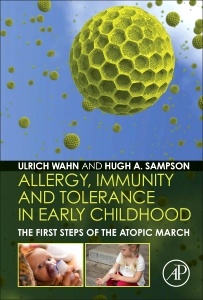Allergy, Immunity and Tolerance in Early Childhood The First Steps of the Atopic March
Coordonnateurs : Wahn Hans Ulrich, Sampson Hugh A.

Allergy, Immunity and Tolerance in Early Childhood: The First Steps of the Atopic March provides valuable insights on the atopic diseases, including asthma, allergic rhinitis, atopic dermatitis, and food allergies, which have developed into major health problems in most parts of the world.
As the natural history of these chronic diseases has been extensively studied, including their major genetic, environmental, and lifestyle determinants and potential protective factors, the book presents tactics on how pediatric allergists can provide early intervention. In addition, the book unites key, global experts in the field who summarize their collective, and current, knowledge of the early stage of the "Atopic March", along with novel ideas for potential options of prevention.
2. Epigenetics
3. What have we missed already by birth
4. B Cell Development
5. Maturation of T cell functions
6. The innate immune system
7. Atopic dermatitis
8. Wheeze and asthma
9. Pollen allergy
10. Lung function
11. Breast –always best?
12. Novel routes for antiallergic vaccination
13. Novel ideas for antiallergic vaccines
14. Antiallergic treatment of the skin
15. Systemic pharmacotherapy
16. Antiviral strategies
17. Adverse reactions of the gut
18. Hydrolysate diets
19. Probiotics-Prebiotics
20. Microbial Compounds
21. Avoidance of allergens
immunologists, pneumologists, allergologist, researchers in public health
1971 - 1972 Postdoc at German Cancer Research Institute, Heidelberg
1972 - 1978 Clinical Training for Pediatrics and Allergology at University Children’s Hospital Heidelberg
1978 - 1979 Research Fellow at National Institutes of Health (Clinical Immunology Section) in Bethesda, USA
1979 - 1981 University Children’s Hospital, Heidelberg Habilitation (Member of the Faculty) Heidelberg, Senior Staff, Member at Children’s Hospital Ruhr-University Bochum
1986 - 1998 Professor for Pediatric Pneumology and Immunology (C3) at Children’s Hospital of Free University Berlin, Chief of Pediatric Pneumology Department, Chest Clinic Heckeshorn
1998 - 2012 Chair and Head of the department für Pediatric Pneumology and Immunology (C4), Charité, Berlin
Functions:
2003 - 2005 President of the European Academy of Allergy and Clinical Immunology
2003 - 2007 Associate Editor: European Respiratory Journal
2003 - 2009 Fachkollegiat of the Deutsche Forschungsgemeinschaft
2010 - 2012 Labor Berlin, Director for Allergy and Immunology
From 2010 Chief Editor: Pediatric Allergy and Immunology (PAI)
Publications: 450 original papers in peer reviewed journals, 30 books/book chapters
Hugh A Sampson, MD, is the Kurt Hirschhorn Professor of Pediatrics, the Dean for Translational Biomedical Sciences, PI and Director of Conduits; Institutes for Translational Sciences (CTSA), and the Director of the Jaffe Food Allergy Institute at the Icahn School of Medicine at Mount Sinai in New York City. Dr. Sampson completed his allergy/immunology fellowship training at Duke University in 1980 and was a faculty member in the Division of Allergy/Immunology at Duke University and then Johns Hopkins University before coming to Mount Sinai. Dr. Sampson’s research interests have focused primarily on food allergic disorders including the immunopathogenic role of food hypersensitivity in atopic dermatitis and anaphylaxis, characteriz
- Summarizes the current knowledge of the epidemiological, genetic, and cellular basis of allergic diseases
- Ideal reference for the study of allergies in young children, atopic dermatitis, allergic rhinitis, childhood asthma, and food allergies
- Provides landmark findings in the field of immunology and allergy development
- Fulfills the need for a book that focuses on primary and secondary allergy prevention, especially during the first years of life
- Unites key, global experts in the field who summarize their collective, and current, knowledge, along with novel ideas for potential options of prevention
Date de parution : 10-2015
Ouvrage de 408 p.
15x22.8 cm
Thème d’Allergy, Immunity and Tolerance in Early Childhood :
Mots-clés :
17q21 chromosomal variants; Adaptive; Airway hyperresponsiveness; Airway tolerance; Allergen microarray; Allergen; Allergens; Allergen-specific IgE; Allergen-specific IgG; Allergic rhinitis; Allergy; Antihistamines; Asthma; Atopic dermatitis; Atopic eczema; Atopic march; Atopy; Avoidance; Bacterial compounds; Breast feeding; Breast milk; Bronchiolitis; Candidate gene; CD14 polymorphism; Cesarean section; Childhood; Children; Chronic health problem; Component-resolved diagnosis; Conjunctivities; Dendritic cell (DC)Induced Treg (iTreg)Oral tolerance; Diagnostic; Dietary intervention; DNA methylation; Environment; Epigenetics; Filaggrin loss-of-function; Flow volume; Food allergy; Gene-by-environment interaction; Genome-wide association studies (GWAS)Linkage; Gut microbiota; Histone modifications; House dust mite allergen; Hygiene hypothesis; IgE; IgE-mediated; Immune development; Immune response; Immune; Immunization; Immunomodulation; Immunotherapy; Infancy; Infant; Infections; Inflammatory; Initiator allergen; Innate; Itching; Long-lived plasma cell; Lung function; Lung; Maturation; Microbiome; Microbiota; Molecular allergy; Molecular spreading; Mucosa; Nasal; Oral tolerance; Pet allergen; Physiological tolerance; Pregnancy; Prevention; Primary avoidance; Primary prevention; Respiratory syncytial virus (RSV)Rhinovirus; Respiratory syncytial virus; Rhinorrhea; Rhinovirus; Risk; Secondary avoidance; Secondary prevention; Sensitization persistence; Sensitization; Skin barrier creams; Skin; Tertiary prevention; Therapy; Tidal breathing; Tolerance induction; Tolerance; Vaccine; Wheeze



